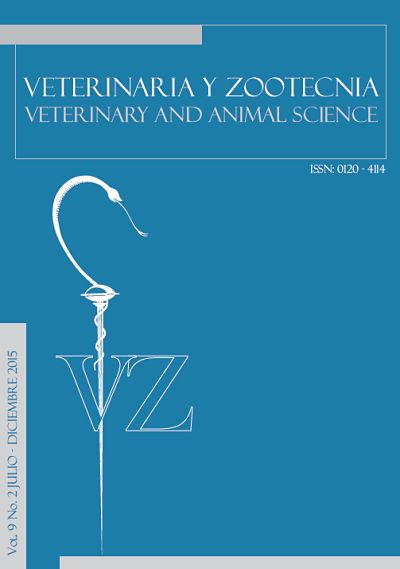Authors
Abstract
Pemphigus Foliaceus is a frequent autoimmune dermatopathy, which can develop either spontaneous, secondary to the use of drugs, or correlated to neoplasms. The different presentations of the Pemphigus complex are accompanied with the existence of antibodies attacking desmosomal proteins that join together the keratinocytes. Lesions may be localized or generalized, and are usually found in the face, nasal planum, auricular area, abdominal region, and in some cases, in paw pads. The diagnosis is based on clinical history, clinical signs, and cytology and histopathology results. The management of Pemphigus Foliaceus is based on administration of immunosuppressive agents. The case report. Canine Pinscher breed, female, castrated, 11 years old, 2 kg weight, coexisting with 2 adult dogs without clinical signs. There are no injuries in the people at home, and their reason for consultation was hair loss, intense scratching and grains. Trichogram, skin scrapings, cytology and histopathology of pustules were used as diagnostic plan. The results of the latest tests had acantholytic cells in common, for which Pemphigus Foliaceus was diagnosed and therapy with oral prednisolone and chlorhexidine shampoo baths were established. Conclusion. The importance of doing first intension testing as trichogram, scraping, and cytology is once again demonstrated, as well as the importance of the use of a histopathological study to obtain an accurate diagnosis and to establish an adequate therapy.
References
Barbosa, M. et al. Patofisiologia do Pênfigo Foliáceo em cães: revisão de literatura. Medicina Veterinária, v. 6, p. 26-31, 2012.
Bizikova, P. et al. Fipronil-amitraz-S-methoprene-triggered pemphigus foliaceus in 21 dogs: Clinical, histological and immunological characteristics. Vet Dermatol, v. 25, p. 103-111, 2014.
Costa-Val, A. Doenças cutâneas auto-imunes e imunomediadas de maior ocorrência em cães e gatos: revisão de literatura. Revista Clínica Veterinária, v. 60, p. 68-74, 2006.
De Abreu, C. et al. Pénfigo foliáceo canino refratário ao tratamento com corticoide sistémico: relato de caso. Enciclopédia Biosfera, v. 10, p. 2279-2290, 2014.
Ferasin, L. Iatrogenic hyperadrenocorticism in a cat following a short therapeutic course of methylprednisolone acetate. J Feline Med Surg, v. 3, p. 87-93, 2001.
Fogel, F.; Manzuc, P. Dermatología canina para la práctica clínica diaria. Buenos Aires: Editorial Inter-Médica S.A., 2009.
Frávega, R. et al. Caso clínico: Pénfigo foliáceo inducido por drogas; un caso asociado a solución tópica. Hospitales Veterinarios, v. 4, p. 41-46, 2012.
Mueller, R. et al. Pemphigus foliaceus in 97 dogs. Vet Dermatol, v. 15 (suppl. 1), p. 26-26, 2004.
Mueller, R. et al. Pemphigus foliaceus in 91 dogs. Journal of the American Animal Hospital Association, v. 42, p. 189-196, 2006.
Olivry, T. A review of autoimmune skin diseases in domestic animals: I - superficial pemphigus. Vet Dermatol, v. 17, p. 291-305, 2006.
Olivry, T.; Chan, L. Autoimmune blistering dermatoses in domestic animals.Clinics in Dermatology, v. 19, p. 750-760, 2001.
Olivry, T. et al. Desmoglein‐3 is a target autoantigen in spontaneous canine pemphigus vulgaris. Experimental Dermatology, v. 12, p. 198-203, 2003.
Rahilly, L. et al. The use of intravenous human immunoglobulin in treatment of severe pemphigus foliaceus in a dog. Journal of Veterinary Internal Medicine, v. 20, p. 1483-1486, 2006.
Rosenkrantz, W. Pemphigus: Current therapy. Veterinary Dermatology, v. 15, p. 90- 98, 2004.
Tater, K.; Olivry, T. Canine and feline pemphigus foliaceus: Improving your hances of a successful outcome. Veterinary Medicine, v. 105, p. 18-30, 2010.
Turek, M. Cutaneous paraneoplastic syndromes in dogs and cats: A review of the literature. Vet Dermatol, v. 14, p. 279-296, 2003.
Valencia, Ó.; Velásquez, M. Inmunopatogenia del pénfigo vulgar y el pénfigo foliáceo. Latreia, v. 24, p. 272-286, 2011.
Yabuzoe, A. et al. Canine pemphigus foliaceus antigen is localized within desmosomes of keratinocyte. Veterinary Immunology and Immunopathology, v. 127, p. 57-64, 2009.

 pdf (Español (España))
pdf (Español (España))
 FLIP
FLIP














